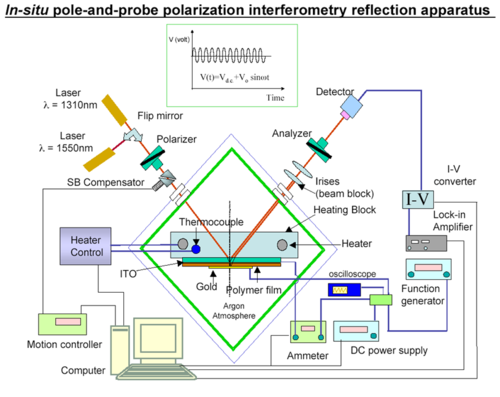Teng-Man Method
Teng-Mann Method for Measuring Electro-optic coefficient
We use the Teng - Man method to measure R33. R33 is an elipsometric measurement. You apply a voltage to the film while making the elipsometric measurements and looking for changes in the signal. You have to be careful with the kind of glass and the kind of tin oxide that is used. These measurements are made with the materials in a device configuration. The formula for R33
- <math>r_{33}= \frac {3\lambda I_m } {4 \pi V_{poly}I_c n^2 } \frac {(n^2 - sin^2 \theta) ^{1/2}}{sin^2 \theta} \approx I_m/ I_c
\,\!</math> where
- <math>I_m\,\!</math> is the amplitude of modulation
- <math>V_{poly}\,\!</math> is the modulation voltage across EO polymer
- <math>I_c\,\!</math> is the half intensity point
- <math>n\,\!</math> is the refractive index of the polymer
and
- <math>V_{poly}= V_{ACtot} \frac {d_{poly}} {d_{poly} + d_{clad}} \cdot \sqrt {\frac {\epsilon_{clad}} {\epsilon _{poly}}}\,\!</math>
The measured quanitities are:
- <math>I= 2I_M\,\!</math> Modulated Intensity
- <math>I_0 = 2I_C\,\!</math> Output intensity
- <math>V_m = V_0 sin\omega t\,\!</math> Modulation Voltage
Teng_Mann techniques allows real-time optimization of processing conditions because you can evaluate r33 during the poling process.
See Khanarian 1996 [1]
See STC-MDITR research project 1.1 [2]
Technique
video to come
Significance
References
</references>
- ↑ Khanarian, et. al., JOSA B13, 1927 (1996)
- ↑ http://stc-mditr.org/research/oeoaomd/projects/1.111.cfm Measuring R33 with Interferometry


